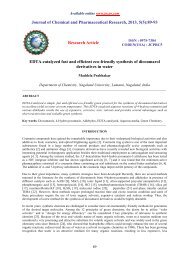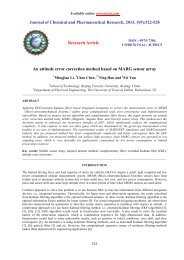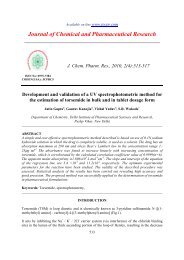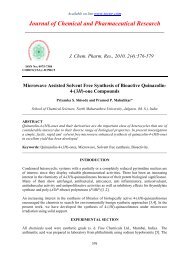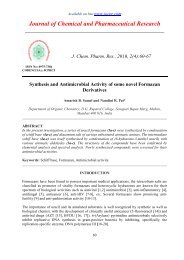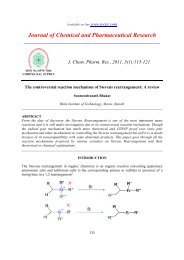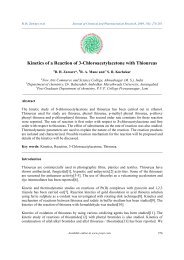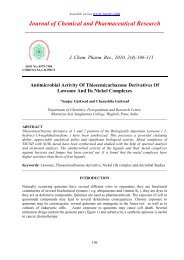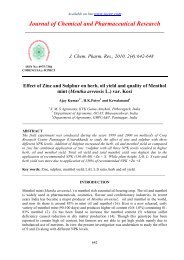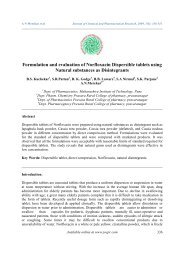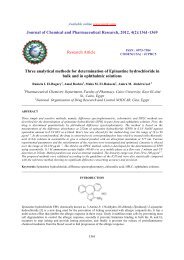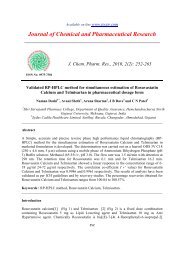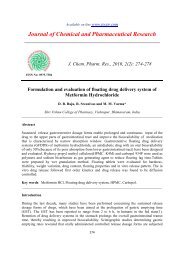Analysis of heavy metals in citrus juice from the Abura-Asebu
Analysis of heavy metals in citrus juice from the Abura-Asebu
Analysis of heavy metals in citrus juice from the Abura-Asebu
Create successful ePaper yourself
Turn your PDF publications into a flip-book with our unique Google optimized e-Paper software.
J. K Tufuor et al J. Chem. Pharm. Res., 2011, 3(2):397-402______________________________________________________________________________plant due to <strong>the</strong>ir physiological functions. The essential elements are very important because <strong>the</strong>yare <strong>in</strong>volved <strong>in</strong> many enzymes systems <strong>in</strong> <strong>the</strong> human body. However, high concentrations aretoxic [4].The sources <strong>of</strong> <strong>the</strong>se <strong>metals</strong> <strong>in</strong> food crops <strong>in</strong>clude discharges onto agricultural lands, wastewater<strong>from</strong> <strong>in</strong>dustries and sewage, application <strong>of</strong> some pesticides, metal aerosol deposition <strong>from</strong> <strong>the</strong>atmosphere due to emissions <strong>from</strong> vehicles and o<strong>the</strong>r sources. These trace <strong>metals</strong> are alsotranslocated <strong>from</strong> <strong>the</strong> soil solution through <strong>the</strong> roots to o<strong>the</strong>r parts <strong>of</strong> <strong>the</strong> plant [5-7]. Cultivation<strong>of</strong> Citrus crops is a major source <strong>of</strong> <strong>in</strong>come for many farmers <strong>in</strong> <strong>the</strong> district. Also <strong>the</strong> lead<strong>in</strong>gexporter <strong>of</strong> lime <strong>juice</strong> <strong>in</strong> Ghana and some <strong>citrus</strong> process<strong>in</strong>g factories obta<strong>in</strong> <strong>the</strong>ir raw materials<strong>from</strong> <strong>the</strong> district. Accumulation <strong>of</strong> <strong>the</strong>se <strong>heavy</strong> <strong>metals</strong> <strong>in</strong> <strong>the</strong> crops <strong>in</strong> higher concentrationscould cause serious risk to human health if <strong>the</strong> crops are consumed and also adversely affectexport. The objective <strong>of</strong> <strong>the</strong> study <strong>the</strong>refore was to:• Determ<strong>in</strong>e <strong>the</strong> levels <strong>of</strong> As, Pb, Cr, Ni, Cu, Zn and Fe <strong>in</strong> orange, lime and lemon fruits grown<strong>in</strong> <strong>the</strong> <strong>Abura</strong>-<strong>Asebu</strong>-Kwamankese District <strong>in</strong> Ghana.• Compare <strong>the</strong> concentrations <strong>of</strong> <strong>the</strong> various <strong>metals</strong> determ<strong>in</strong>ed <strong>in</strong> this study with recommendeddietary reference values for food energy and nutrients levels <strong>in</strong> o<strong>the</strong>r countries.EXPERIMENTAL SECTIONSample collectionOranges, limes and lemons samples were collected randomly <strong>from</strong> different farms, <strong>in</strong> <strong>the</strong> <strong>Abura</strong>-<strong>Asebu</strong> –kwamankese District <strong>of</strong> <strong>the</strong> Central Region <strong>of</strong> Ghana, and placed <strong>in</strong>to appropriatelylabelled sacks and conveyed to <strong>the</strong> laboratory for analysis. For each <strong>citrus</strong> variety, four sampleswere obta<strong>in</strong>ed for each variety.Sample treatmentThe fruits were washed with tap water and <strong>the</strong>n with distilled water after which <strong>the</strong> <strong>juice</strong> weresqueezed <strong>in</strong>to separate beakers. About 200 mL <strong>of</strong> <strong>juice</strong> was obta<strong>in</strong>ed <strong>from</strong> each sample. The<strong>juice</strong> were filtered, mixed well and <strong>the</strong>n stored <strong>in</strong> a refrigerator prior to analysis. 50 mL <strong>of</strong>sample was placed <strong>in</strong>to a 250 mL beaker. 50 mL <strong>of</strong> aqua regia prepared <strong>from</strong> analytical gradeconcentrated 36% HCl and concentrated 63% HNO 3 was added. The mixture was covered with awatch glass, heated and reflux on a hot plate. Additional 10 mL <strong>of</strong> <strong>the</strong> aqua regia was added and<strong>the</strong> heat<strong>in</strong>g cont<strong>in</strong>ued until <strong>the</strong> colour was very light yellow. The last step was repeated and <strong>the</strong>solution evaporated until <strong>the</strong> volume was about 15-20 mL. The solution was cooled and 10 mL<strong>of</strong> 30% H 2 O 2 (AR) added and heated without boil<strong>in</strong>g until effervescence was m<strong>in</strong>imal to ensurecomplete digestion. The heat<strong>in</strong>g was cont<strong>in</strong>ued and <strong>the</strong> volume reduced to about 10 mL. Thebeaker was removed <strong>from</strong> <strong>the</strong> hot plate cooled and <strong>the</strong> walls washed down with double distilled.The digest was filtered us<strong>in</strong>g Whatman No. 4 filter paper <strong>in</strong>to a 50 mL volumetric flask and <strong>the</strong>ndiluted with double distilled water to <strong>the</strong> 50 mL mark. Four samples each <strong>of</strong> <strong>the</strong> <strong>juice</strong> <strong>from</strong>orange, lemon and lime, and also <strong>the</strong> spiked samples and blank were digested us<strong>in</strong>g this method.All <strong>the</strong> digested samples were analysed for As, Pb, Cr, Ni, Fe, Cu and Zn us<strong>in</strong>g InductiveCoupled Plasma Atomic Emission Spectrometer (ICP).398



